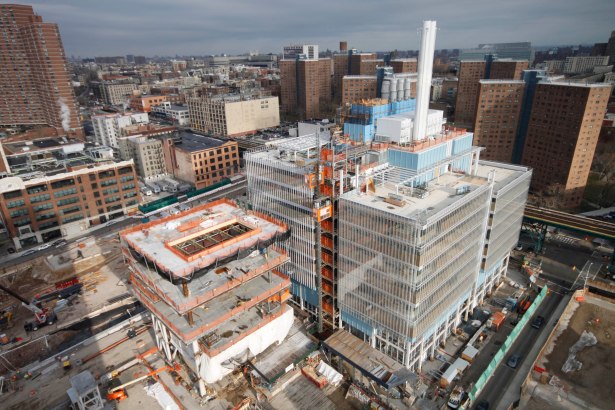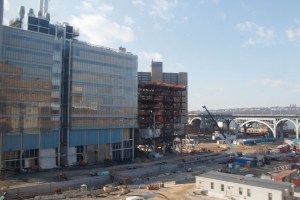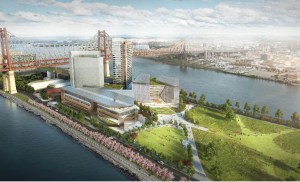
For a moment there, it appeared as if three mammoth university construction projects slated for New York City might never get on the rails. New York University’s 2-million-square-foot expansion in Greenwich Village got tied up in court over the use of park areas during construction, until an appeals court this past October ruled in the school’s favor. Columbia University’s planned 6.8-million-square-foot campus in Manhattanville also faced legal hurdles before the U.S. Supreme Court in 2010 allowed the school to take over property in the blighted community in West Harlem. Finally, Ithaca-based Cornell University is developing the 700,000-square-foot Cornell Tech, an engineering school that will occupy the southern end of Roosevelt Island. That project initially drew the ire of pro-Palestine protestors because of its affiliation with an Israeli university called Technion-Israel Institute of Technology.
Now that all three developments are moving forward, Commercial Observer examines what the projects mean for New York City’s real estate landscape.
Michael Gleicher, a director at Winick Realty Group, which is marketing retail space in the Columbia Manhattanville project, believes the expansions underscore how businesses of every persuasion want a footprint in New York City. “[The projects say] how New York continues to be at the center of the world, not just in finance, but in research, information and technology,” said Mr. Gleichner. “The expansion of the campuses has really put New York City at the forefront.”
Richard T. Anderson, the president of New York Building Congress, views such projects as an engine for growth. “Higher education represents about $2 billion a year in construction activity,” said Mr. Anderson. “It’s a big market. And it helps the economy in two ways. Directly, in work for designers and contractors and crafstmen. Indirectly, it serves as an economic multiplier, where every dollar spent on these projects generates another 50 cents of economic activity.”
|
“[Universities] have gone on a building spree, but it’s not just for students. It’s also a desire to capture research dollars. The building spree is classrooms and dorms, and also incubators, labs and research space.” |
The projects are driven by competition among top-tier colleges. Officials at NYU and Columbia University have said that their expansions will allow them to attract talented faculty and graduated students. And Cornell Tech’s $2 billion campus is the product of an initiative led by former Mayor Michael Bloomberg to increase entrepreneurship and job growth in the city’s technology sector. The university will ultimately compete with schools like The Massachusetts Institute of Technology and Stanford University.
“New York has become a much more compelling place to study and more attractive place to live with a greater likelihood that students will find a quality job,” said Kenneth Hochhauser, an executive vice president at Winick. “So to satisfy that demand, they’ve gone on a building spree, but it’s not just for students. It’s also a desire to capture research dollars. The building spree is classrooms and dorms, and also incubators, labs and research space.”
Here’s an overview of the three projects.
#1 NYU expanding in Greenwich Village
“Our expansion is all about supporting the academic growth,” explained Alicia Hurley, NYU’s vice president for Government Affairs and Community Engagement. For example, genomics didn’t even exist 20 years ago, and now it’s a key source of research in the biology department. To conduct this research, scientists require state-of-the-art labs.
But it’s not only science labs that NYU is developing. It will also construct new humanities and liberal arts classrooms and study centers, so NYU is expanding in many disciplines. Ms. Hurley described the changes as follows: “What will go into the space are: classrooms; study space for students, particularly commuters; performing arts space; academic support space like faculty offices and meeting rooms; a new gym and faculty housing.”
The school calls its master plan “NYU 2031,” which envisioned its campus over the next 20 years. Working with the City Council and community board, it reduced its original plan by 22 percent and compromised on developing 1.9 million square feet. Included in the master plan are five buildings: A Zipper building of 980,000 square feet; a Bleecker Street edifice of 170,000 square feet; one at LaGuardia Place of 114,000 square feet; a Mercer Street building of 69,000 square; and a Washington Square Village below-grade building of 585,000 square feet.
In the past, Ms. Hurley acknowledged that NYU’s real estate acquisitions were done on a piecemeal basis, one building at a time to develop new residences. “Communities, particularly in the East Village, were infuriated because we kept buying buildings and we had no master plan,” she noted.
Some members of the community are upset that NYU is expanding in the Village and they’re losing several retail stores. A Morton Williams grocery store on Bleecker Street will be demolished, and a strip of retail stores on LaGuardia Place that includes a Citibank and Bareburger will make way for another building.
NYU concentrated on developing the buildings it owned rather than extending its footprint into new neighborhoods. “We have 40,000 students, and they’re focused in this area around the Washington Square campus,” Ms. Hurley said.
But many of its classroom facilities were outdated and marred by old-fashioned columns that once anchored manufacturing buildings. It needed to upgrade the classrooms, establish study centers for students and design computer labs.

Even some of its more recently constructed buildings like the Coles Sports Center, which opened in 1981, had become outdated. “It wasn’t even air-conditioned,” Ms. Hurley lamented.
Coles is slated to be demolished and replaced by a new gym, a much-needed performing arts space for the Tisch School of the Arts and housing for about 500 students. Construction won’t begin until late 2015 or early 2016 and will take three to five years to complete. This building will be 25 floors and total 900,000 square feet.
Much of the building takes place below ground, containing auditoriums, practice rooms and classrooms. Beneath the two Washington Square Village buildings there will be a collective 600,000 square feet, she said.
Despite the fact that there have been several protests, accusing NYU of changing the face of the Village and taking away small parks, the local community obtains several benefits. Already a 6,000-square-foot daycare center has opened in one of the Washington Square Village buildings, accommodating about 75 children. A senior outreach office has also opened. And the city was granted five years to determine if it wants to build a public school at a site at 130 Bleecker Street.
Asked about losing green and park spaces, Ms. Hurley said, “Every open space that is there now will be there and better.” Furthermore, NYU maintains the cost of these open spaces, not the city.
The enlarged campus “enables us to recruit the best faculty from around the world who want to be teaching our students and participate in the life of our city. They come with space and lab requirements,” Ms. Hurley asserted.
Cushman & Wakefield’s James Nelson acknowledged that the scale of the NYU project triggered some resistance. But he said for NYU “to be competitive with other universities, they need to provide suitable space to students to learn and to live.”
Bringing in more students boosts the retail environment in Greenwich Village. Without NYU students, Eighth Street would return to being a “ghost town,” he said.
Having a university develop space benefits the neighborhood more than a private developer would, noted Mr. Nelson. Private developers “do what makes the most money. NYU sometimes builds to only half capacity. NYU is respectful and wants to be part of the community,” he said.
#2 Columbia University extends into Manhattanville
The background material describing Columbia’s extension into Manhattanville mentions several of its Ivy League counterparts. Harvard University’s campus contains double the square footage per student as Columbia and Princeton University and Yale University possessed one-third more space. Manhattanville’s 17-acre parcel helps Columbia keep pace.
The entire complex provides 6.8 million square feet of space for teaching, academic research and civic and commercial activities. It includes a new science center, arts center, business school, academic conference center including a 400-seat auditorium, and renovated buildings for administrative services. The arts center, for example, includes the The Miriam and Ira D. Wallach Art Gallery, which is open to the public, a film/video screening room, a flexible theatre space and an open space for writing programs.
|
“[Columbia’s Manhattanville campus] is bringing the neighborhood up substantially; investment in the neighborhood has taken off.” |
Columbia expects that the complex will generate 6,000 full-time jobs and require about 1,200 construction jobs to complete it. Moreover, it creates a vibrant neighborhood with retail space on the ground floor, filled with stores, eateries, cafes and outdoor tables. Unlike Columbia’s Manhattanville expansion, “every street will remain public and open to pedestrians,” the university said.
David M. Greenberg, the executive director and chief operating officer of the Mortimer B. Zuckerman Mind Brain Behavior Institute, noted that for “Columbia to maintain our position as a great research university, it needs to grow and expand. That’s the competitive landscape of universities.” One of its primary goals is establishing its new science center as a leader in “brain science” research, he said.

Combining the science center, business school and arts programs was intentional. Scientists want to “collaborate with humanities, arts and sciences, psychologists, statistics and other researchers,” Mr. Greenberg said.
Hence it was essential to locate Columbia’s new buildings in proximity to its main campus. “You can talk all you want about doing collaborative projects, but if that involves getting in a subway or commuter train, it won’t happen,” observed Kelley Remole, the director of Columbia’s Neuroscience Outreach at the Zuckerman Mind Brain Behavior Institute. “New Yorkers like things close and immediate and scientists are no exception,” she added.
In the past, scientists ensconced themselves in a lab, poring over a microscope but those days are gone.
“What new questions can scientists find if they think not just about the molecular underpinning but how do we function in society?” Ms. Remole wondered. If the scientist considers economic factors, for example, it could alter the neurological research. And Columbia’s new interdisciplinary campus promotes that interchange.
Matthew Sparks, a senior director at Eastern Consolidated, said that the Columbia project has been uplifting the neighborhood. “It is bringing the neighborhood up substantially; investment in the neighborhood has taken off,” he said. He added that the Columbia expansion is serving as an “anchor” in the neighborhood and stimulating more professionals to move north of 125th Street.
Nor does he see any drawbacks in having a university develop it, rather than a for-profit developer. “The effect is very positive, not negative,” he said.
#3 Cornell Tech coming to Roosevelt Island
Cornell wanted to build a tech campus on Roosevelt Island because of “changes in the economy and education for this new digital age,” said Dan Huttenlocher, the dean and vice provost of Cornell Tech. Since universities must collaborate closely with companies to develop new tech tools, operating in an urban environment becomes imperative.
In a competition that Mayor Michael Bloomberg organized, the city offered 10 acres of land and $100 million to support the development. Six colleges including Stanford University, MIT, and Cornell devised plans to build a tech campus where graduate students and tech companies would develop research together, similar to what transpires at Stanford.
When Cornell joined forces with the Technion-Israel Institute of Technology, a public university based in Israel, which stresses science, engineering, medicine and architecture, it strengthened Cornell’s proposal. Cornell is also strong in engineering and computer science, and Technion’s alumni have launched a slew of successful start-ups. Cornell was awarded the right to build a tech campus on Roosevelt Islandin December 2011.
Cornell Tech’s development will last through 2040. Eventually it will encompass 2 million square feet and accommodate 2,000 full-time students and 200 or so faculty.

Because so much of what succeeds in business with tech companies is collaborative, the campus consists of a tech center, business school and law center. The campus combines graduate students in computer science, engineering and technology with M.B.A.s and attorneys.
The demolition of Goldwater Hospital on the south side of the island has already begun. Construction of a five-acre campus begins in January 2015. The 150,000-square-foot academic building consists of four floors with an open-floor plan reminiscent of a newsroom. It will accommodate about 800 graduate students in computer science, media technology and business, and is scheduled to debut summer 2017.
The 225,000-square-foot, six-story second building to be constructed will house tech companies and graduate students. Start-ups can rent space monthly as they would in a tech incubator.
A branch within Cornell Tech, called the Joan & Irwin Jacobs Technion Cornell Institute will specialize in connected media and digital technology. It “focuses on several interdisciplinary programs that tie technology with application areas.”
Mr. Huttenlocher noted that there’s a reasonable amount of retail space available along the island’s main drag, Main Street, which is north of the Queensboro Bridge. But there’s limited retail space near the campus itself. He says the bulk of the island “will remain a residential neighborhood. The transformation will be south of the bridge, where we are creating a destination for digital technology education, research and development.”
The ultimate benefit of Cornell Tech will be “driving the growth of the digital economy in New York City,” noted Mr. Huttenlocher. “Leadership in that community captures financial value and will help preserve New York as a commercial center over the next 10 years.”
Developer David Kramer, the president of Hudson Companies, which is building one of the Cornell Tech residential buildings with Related Companies, said, “The new applied science campus will support retail in Roosevelt Island and give more energy to the island, but not compete with the commuting issue, a perfect set up.” He’s referring to the fact that the overcrowded F train going to Manhattan at rush hour won’t be overtaxed because students will be arriving, not departing.
He said the fears that Roosevelt Island will turn into the East Village and become saturated with bars are groundless. “The truth is we need more shoppers on the island,” he said.
He noted that while there’s a strong contingent of United Nations employees who live on Roosevelt Island, there are also many medical personnel who reside there. Adding 500 to 700 graduate students in the next few years “won’t overrun the island,” Mr. Kramer said.
People choose to live on Roosevelt Island because “it’s safe, quiet, has beautiful views, is convenient to Manhattan and feels like a small town,” Mr. Kramer said. He doesn’t see Cornell Tech as disrupting that ambiance.
“I don’t see any negatives. It’s great for City Hall to use capital to attract a new graduate campus and great for New York City,” Mr. Kramer said.
Additional reporting provided by Tobias Salinger.



